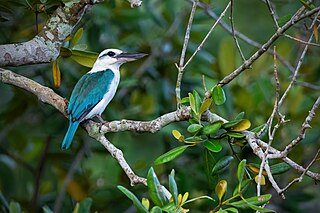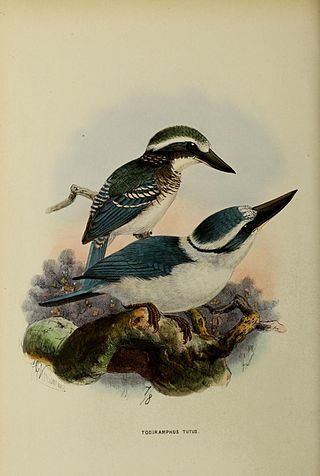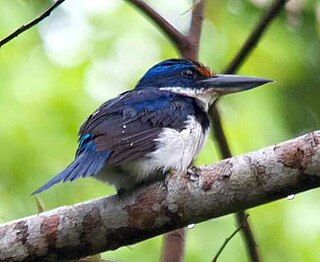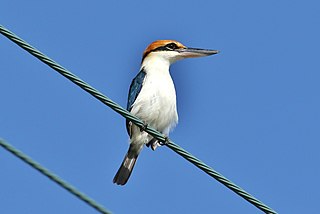
Todiramphus is a genus of kingfishers in the subfamily Halcyoninae that are endemic to the Philippines, New Guinea, Australia, New Zealand and many islands in the South Pacific.

The moustached kingfisher, also called Bougainville moustached kingfisher, is a species of bird in the family Alcedinidae. It is endemic to Bougainville Island in Papua New Guinea. An estimated 250–1,000 mature individuals are left.

The blue-capped kingfisher, also known as Hombron's kingfisher, is a species of bird in the family Alcedinidae endemic to the Philippines and found only on Mindanao. It is one of the most colorful kingfishers in the country having a dark blue cap and wings with rufous spots, a striped rufous belly, white chin and red bill. Its natural habitats are on the upper ranges of tropical moist lowland forest and tropical moist montane forests. It is threatened by habitat loss.

The cinnamon-banded kingfisher is a species of bird in the family Alcedinidae. It is found in Indonesia and East Timor. It is endemic to the Lesser Sundas. Its natural habitat is subtropical or tropical dry forests. It is threatened by habitat loss.

The blue-and-white kingfisher is a species of bird in the family Alcedinidae. It is endemic to North Maluku in Indonesia. It can be found on the islands of Morotai, Ngelengele, Halmahera, Damar, Ternate, Tidore, Moti, Bacan, Obi and Obilatu.

The Talaud kingfisher is a species of bird in the family Alcedinidae.

The sombre kingfisher is a species of bird in the family Alcedinidae. It is endemic to island of Halmahera, in North Maluku, Indonesia.
The Marquesan kingfisher or Marquesas kingfisher is a species of bird in the family Alcedinidae. It is endemic to French Polynesia. It is threatened by habitat loss and predation by introduced species, and is currently classified as Critically endangered, with fewer than 500 individuals left in the wild.

The lazuli kingfisher is a species of bird in the family Alcedinidae. It can be found on the islands of Seram, Ambon and Haruku. Found singly and in pairs in lowland wooded areas, including cultivated areas and mangroves. Pale blue underside is unique among kingfishers in its limited south Moluccan range. Rowdy vocalizations include repetitive “ker-chick” series and “ki-ki-ki-ki…” calls. It gets its name due to its colour being reminiscent of Lapis Lazuli.

The ultramarine kingfisher is a species of bird in the family Alcedinidae.

The blue-black kingfisher is a species of bird in the family Alcedinidae. A medium-sized kingfisher of mangroves and forested streams in the lowlands. It is found in New Guinea and offshore islands of Salawati, Batanta and Yapen. It is considered rare and declining with threats being logging of lowland swamp forests and declining water quality.
The mewing kingfisher or Mangaia kingfisher, known locally as the tanga‘eo, is a species of bird in the Alcedinidae, or kingfisher family. It is endemic to Mangaia in the Cook Islands. Its natural habitats are subtropical or tropical moist lowland forests and plantations.

The beach kingfisher is a species of bird in the family Alcedinidae. It is found in Indonesia, Papua New Guinea, and Solomon Islands. Its natural habitat is subtropical or tropical mangrove forests.

The chattering kingfisher is a species of bird in the kingfisher family Alcedinidae. The species is found in the Cook Islands and the Society Islands in French Polynesia.

The Society kingfisher or Tahiti kingfisher is a species of bird in the family Alcedinidae. It is endemic to the Society Islands of French Polynesia. Its natural habitats are subtropical or tropical moist lowland forest and subtropical or tropical moist montane forest.

The rufous-lored kingfisher, also known as Winchell's kingfisher, is a species of bird in the kingfisher family Alcedinidae. It is endemic to the Philippines, its natural habitat being lowland forests. It is threatened by deforestation, and the International Union for Conservation of Nature (IUCN) has assessed it as a vulnerable species.

The Pohnpei kingfisher is a species of bird in the family Alcedinidae. It is endemic to Pohnpei. Its natural habitat is subtropical or tropical moist lowland forests. It was formerly considered to be a subspecies of the Micronesian kingfisher.

The tree kingfishers, also called wood kingfishers or Halcyoninae, are the most numerous of the three subfamilies of birds in the kingfisher family, with around 70 species divided into 12 genera, including several species of kookaburras. The subfamily appears to have arisen in Indochina and Maritime Southeast Asia and then spread to many areas around the world. Tree kingfishers are widespread through Asia and Australasia, but also appear in Africa and the islands of the Pacific and Indian Oceans, using a range of habitats from tropical rainforest to open woodlands.
The Mangareva kingfisher, also known as Tuamotu kingfisher, is a species of kingfisher in the family Alcedinidae, endemic to Niau in French Polynesia. It is classified as critically endangered.

The rusty-capped kingfisher or Palau kingfisher is a species of bird in the family Alcedinidae. It is endemic to Palau. The natural habitat of this species is subtropical or tropical moist lowland forests. It was formerly considered to be a subspecies of the Micronesian kingfisher.

















